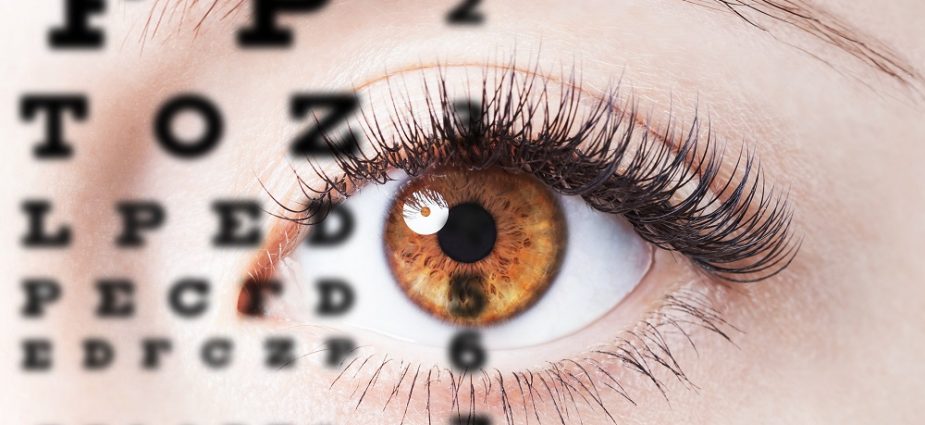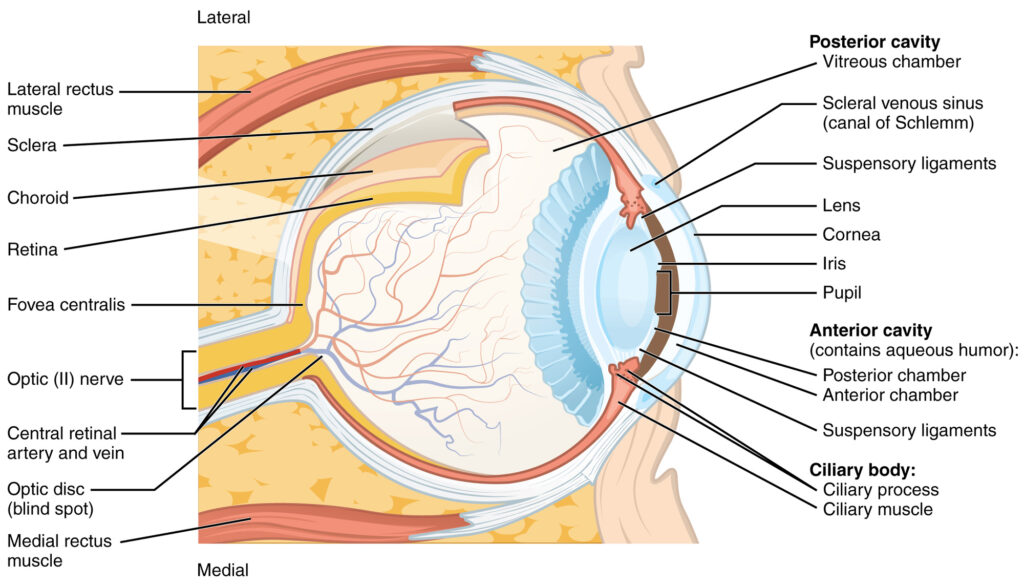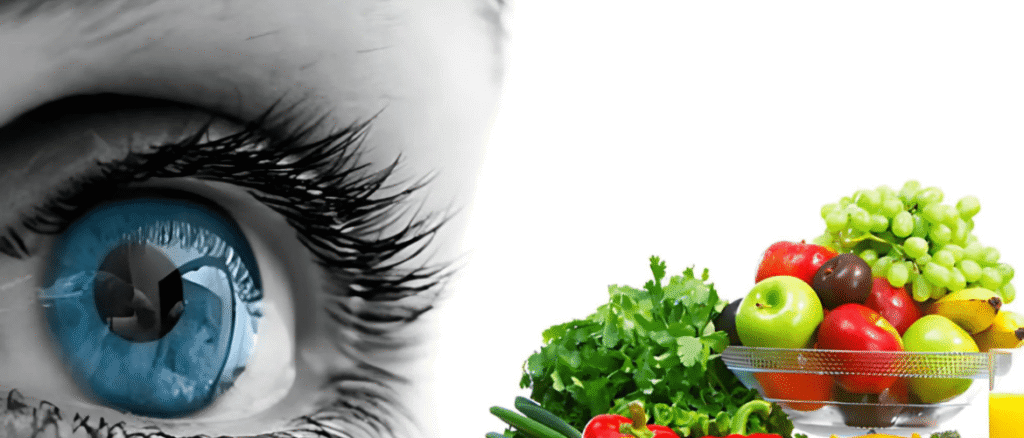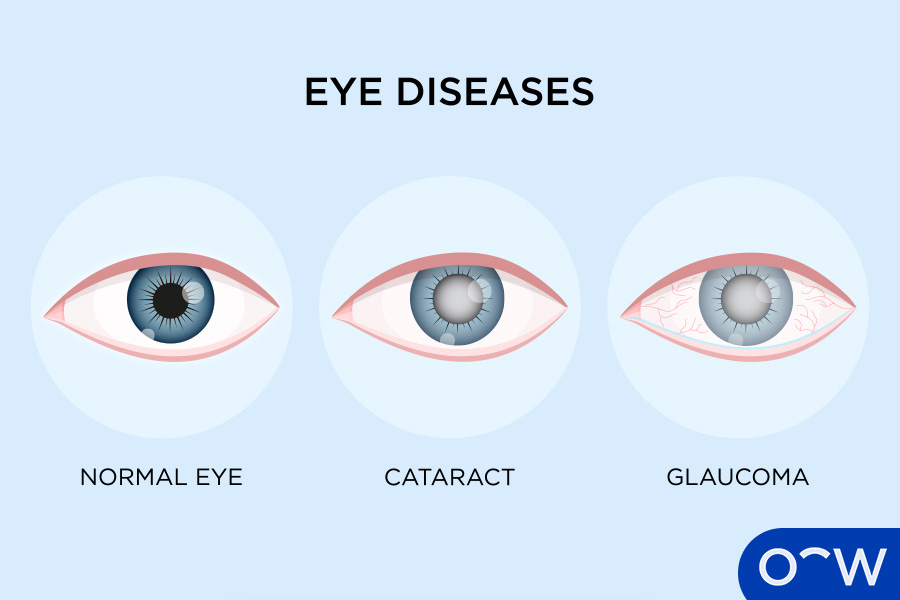
Eye health is crucial for maintaining clear vision and preventing long-term damage. Proper nutrition, early detection of diseases, protective habits, and awareness of warning signs help preserve vision, while modern treatments and imaging technologies significantly improve eye-care outcomes.
Key Takeaways
- Eye-care needs vary by age, making timely childhood screenings and senior eye checks essential.
- Essential nutrients like vitamins A, C, E, lutein, omega-3s, and zinc protect the retina and support optimal vision.
- Major eye diseases include cataracts, glaucoma, AMD, dry eye syndrome, and diabetic retinopathy, all requiring early diagnosis.
- Key habits: regular eye exams, UV-blocking sunglasses, 20-20-20 rule, quitting smoking, and good hydration.
- Innovations such as pilocarpine drops, OCT imaging, regenerative therapies, and adjustable lenses enhance treatment options.
- Warning signs like sudden vision loss, flashes, intense pain, or halos need urgent medical attention.
Introduction to Eye Health
Vision plays a vital role in everyday life, from simple tasks like reading to complex ones like driving. Protecting eye health early on helps prevent disorders that can impair sight permanently. Aging, genetics, diet, environment, and habits all affect the eyes. Understanding these factors supports good eye care practices for lasting vision.
Understanding Eye Anatomy and Function

The eye is a complex organ with parts working together to capture and process light into images. Key components include:
- Cornea: Clear front layer that bends light toward the inside of the eye.
- Iris: Colored ring that adjusts the size of the pupil based on light intensity.
- Pupil: Opening controlled by the iris that allows light to enter the eye.
- Lens: Transparent part behind the pupil which focuses light onto the retina.
- Retina: Layer at the back of the eye with photoreceptor cells that detect light and color, sending signals to the brain.
- Optic nerve: Transmits those signals from the retina to the brain to produce what we see.
Essential Nutrients for Eye Health

Certain nutrients have been proven to support eye function and protect against oxidative damage from light and aging.
- Vitamin A: Vitamin A is critical for producing retinal pigments that allow the eyes to sense light and adapt to different brightness levels. It also keeps the cornea, the clear front layer of the eye, healthy and moist. Without enough vitamin A, people can experience night blindness and dry eyes. Animal foods like liver, egg yolks, and dairy products provide active vitamin A, while plant-based provitamin A carotenoids like beta-carotene, found in carrots, spinach, and kale, are converted into vitamin A by the body.
- Vitamin C: Vitamin C is a powerful antioxidant that protects eye cells from free radicals, unstable molecules that can cause cell damage and contribute to cataracts and age-related macular degeneration (AMD). Vitamin C also supports the health of blood vessels in the eye. Good sources include citrus fruits, green peppers, broccoli, and strawberries.
- Vitamin E: Vitamin E works alongside vitamin C to reduce oxidative stress in eye tissues. The retina contains many fatty acids vulnerable to damage, and vitamin E helps protect these fats, maintaining healthy vision. Almonds, sunflower seeds, wheat germ, and vegetable oils are rich in vitamin E.
- Lutein and zeaxanthin: Lutein and zeaxanthin are carotenoid antioxidants concentrated in the macula the central part of the retina responsible for sharp vision and color perception. These nutrients act like natural sunglasses, filtering out harmful blue light and reducing oxidative damage. Dark green leafy vegetables such as spinach, kale, and collards, as well as egg yolks, corn, and peas, are rich sources. Eating lutein and zeaxanthin with healthy fats enhances absorption. For more on dietary support for eyes, explore foods that boost eye health.
- Omega-3: Omega-3 fatty acids, especially DHA, are essential components of retinal cell membranes and support retinal function. They also help maintain a healthy tear film, reducing dry eye symptoms by enhancing tear production. Fatty fish like salmon, tuna, and mackerel are excellent sources of omega-3s.
- Zinc: Zinc is abundant in the eye and vital for transporting vitamin A from the liver to the retina, where it helps produce melanin, a protective pigment. Zinc deficiency has been linked to poor night vision and an increased risk of AMD. Foods high in zinc include oysters, red meat, pumpkin seeds, and nuts.
Common Eye Conditions and Diseases
Eye diseases can significantly impact vision if unnoticed or untreated. Many develop silently over time.

- Refractive Errors: These include myopia (nearsightedness), hyperopia (farsightedness), and astigmatism, caused by irregular focusing of light on the retina. Corrective lenses or surgery improve vision.
- Cataracts: A clouding of the lens causing blurred or dim vision, common with aging. Surgical removal of the cloudy lens is the standard treatment.
- Glaucoma: Known as the “silent thief of sight,” glaucoma damages the optic nerve due to increased intraocular pressure. Symptoms come late, so early screening is vital.
- Age-Related Macular Degeneration (AMD): Affects the macula, the central part of the retina, impairing sharp vision needed for reading and recognizing faces. Lifestyle changes and medications can slow progression.
- Dry Eye Syndrome: Caused by reduced tear production or increased tear evaporation, leading to irritation, redness, and blurred vision. Understanding its causes such as Meibomian gland dysfunction helps with targeted treatment.
- Diabetic Retinopathy: Damage to retinal blood vessels from high blood sugar levels, leading to vision loss if uncontrolled.
- Eye Infections: Common infections like conjunctivitis require hygiene and treatments to prevent spread and complications. Persistent symptoms like itchy dry eyes warrant medical attention.
Lifestyle Habits for Maintaining Healthy Vision
Maintaining healthy vision is achievable through simple, consistent habits applied daily. These habits protect your eyes from damage, reduce strain, and lower the risk of common eye diseases.
- Regular Eye Exams: Scheduling comprehensive eye exams every 1 to 2 years is essential. For adults over 60 or those with risk factors such as diabetes or family history of eye diseases, annual checks are recommended. Eye exams detect early changes before symptoms appear, allowing timely treatment for conditions like glaucoma, cataracts, and macular degeneration.
- Wearing UV-Blocking Sunglasses: Prolonged exposure to ultraviolet (UV) rays from the sun damages eye tissues over time, increasing the risk of cataracts and age-related macular degeneration (AMD). Always wear sunglasses that block 99% to 100% of UVA and UVB rays. Wraparound styles offer better side protection. Pairing sunglasses with wide-brimmed hats further reduces UV exposure.
- Digital Eye Strain Prevention: The 20-20-20 Rule: Extended screen time causes eye fatigue, dryness, and blurred vision, known as digital eye strain. Follow the 20-20-20 rule every 20 minutes, look at an object 20 feet away for at least 20 seconds. This practice relaxes eye muscles, reduces focusing fatigue, and encourages blinking to keep eyes moist.
- Quitting Smoking: Smoking exposes the eyes to harmful toxins and oxidative stress, doubling the risk of developing cataracts and AMD. Quitting smoking slows progression of these diseases and improves overall eye and systemic health.
- Staying Hydrated and Getting Adequate Sleep: Proper hydration supports tear film production, preventing dry eyes and irritation. Aim to drink at least eight glasses of water daily. Sufficient quality sleep allows eye tissues to repair and regenerate overnight, maintaining clear vision and eye comfort.
- Maintaining a Healthy Diet Rich in Antioxidants and Omega-3s: Consuming foods rich in vitamins A, C, and E, antioxidants like lutein and zeaxanthin, and omega-3 fatty acids helps protect eyes from oxidative damage. These nutrients reduce inflammation, support retinal health, and lower disease risks. Include leafy greens, citrus fruits, nuts, seeds, fish, and eggs regularly in your meals.
- Managing Screen Time and Workspace Setup: Limit continuous screen use and arrange your workspace to minimize strain Place screens about an arm’s length away, with the top of the monitor at eye level or slightly below. Adjust screen brightness to match surrounding lighting. Reduce glare using matte screen filters or positioning your screen away from direct light sources. Take frequent breaks to rest your eyes.
Innovative Eye Care Advancements in 2025
Eye care continues to evolve rapidly, with groundbreaking technologies and treatments offering new hope for improving and preserving vision. These recent innovations focus on enhancing eye function, early disease detection, and minimally invasive solutions.
Pilocarpine-Based Eye Drops for Presbyopia
Pilocarpine eye drops offer a breakthrough non-surgical solution for presbyopia, the age-related difficulty in focusing on close objects. These drops improve the eye’s focusing ability by gently constricting the pupil, increasing the depth of focus. This helps many people regain near vision without needing reading glasses or invasive procedures.
Advanced Retinal Imaging
High-resolution retinal imaging techniques such as Optical Coherence Tomography (OCT) enable early detection of eye diseases including age-related macular degeneration (AMD) and diabetic retinopathy. These scans provide detailed cross-sectional images of the retina, revealing cellular changes before symptoms develop, allowing for timely and personalized treatment.
Cell Regeneration Research
Emerging regenerative therapies focus on repairing damaged retinal cells and optic nerve fibers, offering hope for vision restoration in previously untreatable conditions. Early-stage clinical trials use stem cells and gene therapy to replace or regenerate retinal tissue, signaling a new frontier in treating degenerative eye diseases.
Non-Surgical Vision Correction Technologies
Innovations like light-adjustable intraocular lenses allow for post-surgical fine-tuning of vision without additional procedures. Additionally, advanced contact lenses with enhanced comfort, durability, and drug release capabilities help manage complex conditions such as severe dry eye and corneal irregularities, providing effective vision correction without surgery.
Recognizing Warning Signs and When to Seek Help
Early recognition of eye problems is vital to prevent permanent damage and preserve vision. Certain symptoms require urgent medical attention as they may signal serious conditions.
- Sudden Vision Loss or Blurring: If vision disappears suddenly or becomes noticeably blurred, seek immediate care. This could indicate retinal detachment, stroke, or other emergencies where rapid treatment is crucial to avoid permanent blindness.
- Flashes or Floaters: Seeing flashes of light or a sudden increase in floating spots or cobweb-like shadows may mean the retina is being disturbed or torn. A curtain-like shadow spreading over vision is an urgent sign of retinal detachment needing prompt evaluation.
- Persistent Eye Pain or Redness: Constant or severe eye pain, especially if accompanied by redness, can signal infections, inflammation, glaucoma, or injury. These symptoms require timely examination to prevent complications.
- Difficulty Seeing at Night or Double Vision: Trouble seeing well in low light or experiencing double vision might indicate early stages of eye diseases or neurological issues. Early diagnosis improves management outcomes.
- Halos Around Lights or Tunnel Vision: Halos or rainbow-colored rings around lights and loss of peripheral (side) vision are classic glaucoma signs. Since glaucoma often has no pain, noticing these visual changes should prompt an urgent check-up.
Eye Care Across Different Age Groups
Eye care needs vary by age.
- Children: Early screenings detect conditions affecting learning such as amblyopia (lazy eye). Corrective lenses and treatments are effective when started early.
- Adults: Many develop new refractive errors or early signs of degeneration; regular checkups help manage changes.
- Seniors: Frequent exams are necessary since cataracts, glaucoma, and AMD risk increases with age. Supportive care maintains independence.
Age-appropriate care ensures eye health throughout life stages.
Conclusion
Maintaining eye health is crucial for good vision and quality of life. Key nutrients vitamins A, C, E, lutein, omega-3, and zinc support eye function and protect against diseases. Common conditions like cataracts, glaucoma, and macular degeneration need early detection and management. Daily habits such as regular eye exams, UV protection, and breaks from screens reduce damage.
New treatments and technologies continue to advance care. Awareness of warning signs like sudden vision changes or eye pain prompts swift treatment. Age-specific eye care recommendations help keep vision sharp from childhood through old age.
FAQs
What causes near sightedness and far sightedness?
Nearsightedness happens when the eye is too long or the cornea curves too much, causing light to focus in front of the retina and making distant objects blurry. Farsightedness occurs when the eye is too short or the lens is less flexible, causing light to focus behind the retina and making close objects hard to see clearly.
How often should adults get eye exams?
Adults should have eye exams every two years or annually if they are over 60 or have risk factors like diabetes or family history of eye disease. Regular exams help detect problems early and maintain vision health.
Can diet improve eyesight or prevent eye diseases?
Yes, eating foods rich in vitamins A, C, and E, lutein, and omega-3 fatty acids supports eye health. Leafy greens, fruits, fish, and nuts provide these nutrients and may reduce the risk of common eye diseases.
Are treatments beyond glasses available?
Yes. Treatments include contact lenses, laser surgery like LASIK, new eye drops, and surgeries for cataracts and glaucoma, offering options beyond just glasses.
How can I reduce eye strain from digital devices?
Use the 20-20-20 rule: every 20 minutes, look at something 20 feet away for 20 seconds. Adjust screen settings, reduce glare, and blink often to prevent dryness and discomfort.
What are early symptoms of glaucoma or macular degeneration?
Glaucoma often causes gradual side vision loss without pain, while macular degeneration usually affects central vision, causing blurriness or distortion. Early exams are critical for detection.
Can cataracts be reversed without surgery?
No. Surgery is currently the only effective treatment to remove cataracts and improve vision.
What should I do if vision suddenly changes or eyes hurt?
Seek immediate medical care. Sudden vision changes or pain can indicate serious eye emergencies needing prompt treatment.
Are sunglasses needed if contact lenses have UV protection?
Yes. Sunglasses protect the entire eye area, including eyelids and skin, from UV damage, which contact lenses alone cannot block.
Can eye drops replace reading glasses for presbyopia?
Some new eye drops may improve near vision but might not fully replace reading glasses for everyone. Use depends on individual needs.
Reference
- National Eye Institute (NEI) – Comprehensive eye health resources
https://www.nei.nih.gov/ - American Academy of Ophthalmology (AAO) – Eye Health and Diseases
https://www.aao.org/eye-health - American Optometric Association (AOA) – Eye Exams and Vision Care
https://www.aoa.org/healthy-eyes/caring-for-your-eyes - Centers for Disease Control and Prevention (CDC) – Vision Health
https://www.cdc.gov/vision-health/index.html - World Health Organization (WHO) – Eye Care in Health Systems
https://www.who.int/publications/i/item/9789240050068 - Healthline – Nutrients for Eye Health
https://www.healthline.com/nutrition/8-nutrients-for-eyes - WebMD – Eye Strain and Digital Eye Health
https://www.webmd.com/eye-health/eye-strain - Cleveland Clinic – Eye Anatomy and Common Conditions
https://my.clevelandclinic.org/health/body/21823-eyes
Dr. Amiah Rainey researches diet–disease relationships with expertise in vitamins, minerals, and biomarker methods. She earned a PhD from Harvard T.H. Chan School of Public Health (2019) and completed a postdoctoral fellowship at the NIH/NIDDK. With ~20 peer-reviewed publications (example) and experience on NIH-funded cohort studies, Amiah translates complex evidence into practical guidance. She advises on study design, evidence grading, and data transparency. Profiles: ORCID, Google Scholar; list affiliations and any disclosures.

